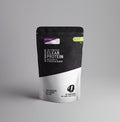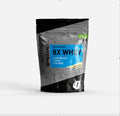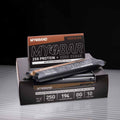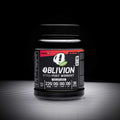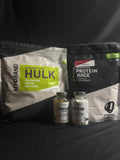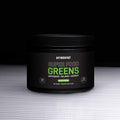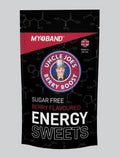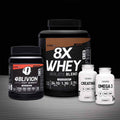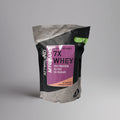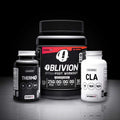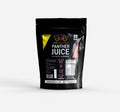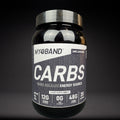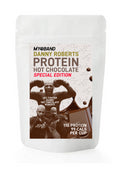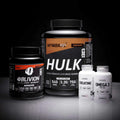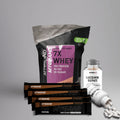Delayed Onset Muscle Soreness: How Best to Recover
Posted by LIAM KINGSWELL

Author: Gareth Sapstead - MYOBAND Fitness Director
Delayed-Onset Muscle Soreness or D.O.M.S is that feeling that most of us have experienced usually 24-48 hours after a hard workout. It usually lasts for up to 96 hours, but not uncommon to last even longer. It’s that feeling of pain, tenderness, and stiffness that some of us love because it makes us feel as though we’ve had a good workout. But, for others, it’s a struggle to get out of bed the next morning and stay motivated to keep working out.
What is D.O.M.S?
The severity of the soreness is dictated by a number of factors, including your familiarity with the exercises used during a workout, the intensity of exercise, eccentric loading of the muscles, how much a muscle has been stretched under resistance, and the angle of muscle contraction. If you’re doing a lot of these things, chances are you’re going to be experiencing D.O.M.S quite often.
We know what types of exercise can cause D.O.M.S, and often just through personal experimentation we know how to get sore if we really wanted to. However, the underlying mechanisms behind post-exercise soreness is somewhat of a mystery. Although research has come up with a number, or combination of mechanisms responsible, science doesn’t know with 100% certainty what D.O.M.S actually is.
To date, mechanical damage of the muscle tissue, inflammation and swelling, and increase in free radical production have all been suggested to contribute to the symptoms associated with D.O.M.S.
Mechanical Damage
The response to localised muscle damage is one that can be compared to a muscular injury and the inflammatory response to an infection. A large rate of tissue breakdown occurs during exercise when working at greater intensities, and closer to the maximum weight you can lift (i.e., the higher the percentage of maximal weight you lift the greater the rate of mechanical damage). Furthermore, emphasising the eccentric component of an exercise, performing a stretch of the muscle while it is being worked, or overloading the eccentric portion of the exercise by using a greater weight on the eccentric/downward phase, can form high amounts of mechanical tension and tissue breakdown.
The result here is inevitable soreness the day after. If you want sore quadriceps the next day then just try doing a few sets of eccentric-focused leg extensions where you lift concentrically with both legs but only lower with one, for example.

When muscles passively stretch (stretching a muscle without actively tensing it) this is what’s referred to as passive elastic tension. On the other hand if you place tension on a muscle by isometrically (statically) flexing it as hard as possible, this is what’s referred to as active tension. During both types of stretch high amounts of mechanical tension are formed. Taking a muscle through its full range of motion and lengthening, or “stretching” it whilst also using resistance has been shown to produce a large amount of mechanical damage. For example stretching the pectoral muscles fully during dumbbell flyes, and performing what has sometimes been referred to as a “loaded stretch”, has been shown to trigger large amounts of post-exercise soreness. High amounts of mechanical tension are produced during these type of actions, as high eccentric force is being produced by the muscle in a lengthened state.
Inflammation, Swelling and Free Radicals
Certain forms of exercise, including eccentric exercise in particular can result in injury to the muscle cell membrane, setting off an inflammatory response that leads to prostaglandin and leukotriene production. Leukotrienes are responsible for controlling the inflammation process and prostaglandins (specifically PGE2) directly causes the pain sensation associated with D.O.M.S by making certain pain receptors more sensitive to the effects of various chemical messengers. Leukotrienes also increase vascular permeability and attract neutrophils to the area of damage. In Layman’s terms this means that molecules can pass through capillaries easier and a build-up of white blood cells occur. These neutrophils generate free radicals which can also increase damage to the cell membrane. Swelling results from the movement of cells and fluid from the bloodstream in to the spaces between the muscle tissues with inflammation, and can contribute to the sensation of pain.
In a way we want this response. This seemingly negative response involving an increase in free radicals, is actually part of a cascade of events that lead to us ultimately adapting to exercise, and getting better, stronger and so on. It’s one of the reasons why many would not recommend the use of high dose antioxidants pre or post workout, as it might affect this response. If you’re using supplements like SUPERFOOD GREENS or VITAMIN C + which all include antioxidants then you’re best to use these outside of your workout window.
Is D.O.M.S Good or Bad?
In short, feeling D.O.M.S doesn’t necessarily mean that you’ve had a good workout. It’s more of a sign of the type of workout you’ve done, how unaccustomed to the workout you could have been, or the types of exercises you were using. You’ll also find that the more experienced you are in the gym, or in your sport, the less muscle soreness you’ll experience over time as your body becomes more accustomed to the exercise.
A caveat to this however is that the types of exercise D.O.M.S can be associated with, and in particular producing large amounts of mechanical damage, can lead to greater increases in muscle size. So a feeling of post-exercise soreness may be expected in sessions where maximal growth and strength development are your goals.
The cellular swelling and inflammation associated with D.O.M.S can also be of use in small doses, so any strategy you use to reduce these (i.e., use of anti-inflammatory drugs, treatment with ice or compression) should be carefully considered not to be overdone. D.O.M.S is absolutely normal, so suck it up and stretch it off!
Supplements to Help D.O.MS.
In order to help alleviate the feeling of D.O.M.S supplements and nutritional strategies should be chosen based around:
- Allowing muscle tissue to optimally recover from mechanical damage
- Controlling inflammation and swelling. And,
- Reducing free radicals
In order to help muscle tissue recover from a training session a number of nutritional supplements could be suggested. The main goal here would be to increase muscle protein synthesis post-exercise, and limit protein degradation. The most recommended approach to use would be to consume an adequate amount of protein (a complete source of amino acids) both 30 minutes prior to training, and immediately after. The most convenient way to do this would be in the form of a protein shake consisting of a fast acting protein such as that found in OBLIVION PROTEIN JUICE. On top of this depending on whether carbohydrates fit in to your current nutritional plan, a little fast acting carbohydrate, such as 30-60g of cyclic dextrin (the primary ingredient found in our CARBS powder) may also aid in recovery and reduce post exercise soreness.

Controlling inflammation, swelling and reducing free radicals, however, is a much harder task to achieve. Due to the relationship between inflammation and free radicals and the mechanisms involved; various anti-oxidants have been suggested to help aid in the process and reduce the severity of D.O.M.S. The most researched of these anti-oxidants include vitamins C and E. Studies in this area have produced inconsistent results, however 400iu up to 1000iu of vitamin E and 3g of vitamin C per day seem to be the most effective dose for reducing post-exercise soreness. A good MULTI will contain both, as well as a specialized VITAMIN C+ supplement being a good option. But remember, try to avoid these around your workouts.
Finally, another anti-oxidant that has gained some attention in recent years is green tea extract. Because of the numerous benefits of green tea, it may be effective at slowing down the oxidative stress process that’s usually brought about through post-exercise soreness. MYOBAND SUPERFOOD GREENS contains both green tea as well as sources of vitamin C and other powerful antioxidants.
Additional supplements that have been investigated include arnica, ubiquinone (coenzyme-Q) and L-carnitine. These supplements have all been shown to have some benefit when it comes to reducing post-exercise soreness, although there’s very little research that’s been done on this area.
With all these supplements listed above the best advice may be to experiment and see what works for you. If D.O.M.S isn’t bothering you though then just leave it alone, as this could be the best thing for your long term progress.
D.O.M.S FAQ’s
Does D.O.M.S affect strength and performance? Performance should not be affected by feelings of soreness, and feeling sore is not necessarily a sign that your body has not fully recovered. D.O.M.S can only affect performance (e.g., how much weight you can lift, how fast you can run etc.) through more psychological reasons, as feelings of soreness can often be uncomfortable. There are no physiological reasons however.
Can I train when I’m sore? Yes, providing you feel as though your body has recovered and your performance won’t be hindered.
Is feeling D.O.M.S the sign of a good workout? Absolutely not, it’s only a sign that you may have done something new, your workout may have involved a lot of eccentric lifting, or you yourself are fairly new to exercise.
How long should D.O.M.S usually last? Usually for around 96 hours, but it’s not uncommon for it to last longer.
What exercises typically produce the most soreness? Exercises that emphasise stretching the muscle under contraction (such as chest flyes, deep squats, and stiff-legged deadlifts), exercises that emphasise or overload the eccentric/downward portion of a lift, and any exercise you may not be accustomed to.
What does it mean if I never feel sore after a workout? This could be from a number of reasons, but as previously mentioned isn’t a sign that you have not worked hard enough in your workout. People more experienced with exercise typically find it hard to achieve that feeling of soreness after a workout or training session, and almost relish the feeling of D.O.M.S when it comes about, whereas novices are typically sore as a result of even a few sets of exercise.
TAGS:
